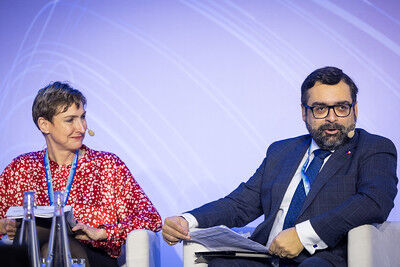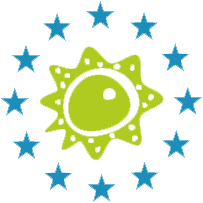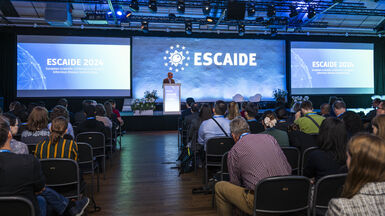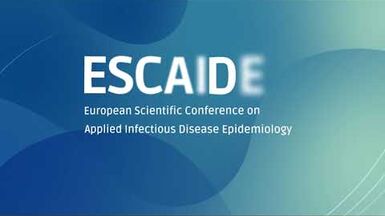ESCAIDE 2025 - A summary of day 2
The theme of the second day of ESCAIDE was One Health, with sessions on the intersection between veterinary and human health, the role of the environment in public health, and the EU's One Health task force. It also featured sessions on new developments and approaches in vaccines.

The second day of ESCAIDE 2025 kicked off with plenary session C, 'The third pillar of One Health: why environment can't be an afterthought.'
The session looked at the often underrepresented environmental pillar of the One Health approach. Speakers discussed how environmental systems shape global health risks. Drawing on examples from EU Member States, the session considered ways to strengthen
integrated surveillance and preparedness across human, animal, and environmental sectors. Wastewater monitoring was highlighted as one environmental surveillance tool with potential for early detection of health threats. In summary, the session outlined practical lessons and policy considerations to support more coordinated One Health implementation, as currently there is too much fragmentation.
‘Weather can potentially trigger a sequence of secondary events, when risks are causally connected, with one triggering the next. These cascading risk pathways can result in large-scale waterborne disease outbreaks.’ - Jan Semenza, environmental epidemiologist at Umeå University, speaking at Plenary C
The third thematic session, 'Impact of the new use of conjugate pneumococcal vaccines on invasive pneumococcal disease: current status of evidence', outlined the progression of pneumococcal conjugate vaccine (PCV) products and provided a detailed overview of the evolving epidemiological situation of invasive pneumococcal disease (IPD) in the EU/EEA, with a particular focus on the serotype distribution by year, age, clinical outcomes and other factors. The high burden of IPD in comparison to other infectious diseases was emphasised, and findings on the impact of PCVs on the IPD burden were discussed. The session underscored the diversity of vaccine recommendations across Member States in the EU/EEA and provided perspectives on different vaccination schedules. Varying vaccine coverages across the EU/EEA and the potential for closing immunity gaps were discussed.

Session Chair Piotr Kramarz stated that ‘There is a high burden of disease caused by pneumococci, there are effective vaccines, but often vaccine coverage is suboptimal and we have to work on it together.’
The Eurosurveillance seminar, 'Vaccines and tomorrow’s opportunities for public health' saw the session’s three expert presentations focusing on antimicrobial resistance (AMR), emerging arboviruses, and climate-driven vector-borne diseases.
Mateusz Hasso-Agopsowicz highlighted AMR as a persistent global health threat, linked to an estimated 4.7 million associated deaths in 2021. He emphasised that vaccines are an underused tool in AMR strategies. He called for stronger integration of vaccines into national and global AMR plans, rapid scale-up of existing vaccines, and expanded coverage to meet IA2030 targets.
‘Vaccines are one of the strongest tools we have to reduce antimicrobial resistance. They prevent infections, reduce antibiotic use, and slow the spread of resistance’, - Mateusz Hasso-Agopsowicz, Technical Officer at the World Health Organization, speaking at the Eurosurveillance seminar
Gerald McInerney discussed the growing global burden of chikungunya virus, now responsible for an estimated 106 000 DALYs each year. Once largely confined to Africa and Asia, the virus has expanded into the Americas and, increasingly, Europe, with France experiencing an outbreak earlier this year. He described the mechanisms of alphavirus replication, the drivers of joint-associated disease, and current progress toward a chikungunya vaccine.
Turning to dengue, Fernanda Boulos described it as the world’s fastest-growing mosquito-borne infection and a pandemic-prone threat intensified by rising temperatures and expanding mosquito habitats Drawing on Brazil’s 2024 epidemic - where incidence exceeded 3 000 cases per 100 000 - she underscored the need for a coordinated response combining surveillance, vector control, vaccination, and community engagement.
The fourth thematic session of the conference, 'Europe’s Cross-Agency One Health Task Force', discussed the task force which unites five EU agencies (ECDC, ECHA, EEA, EFSA and EMA) to strengthen prevention and response to health threats. The speakers discussed the common “Framework for Action”, which includes five strategic objectives (SO) and stressed the importance of their collaboration.
‘We came to a simple conclusion: we can’t solve One Health alone. We need to work together. We need each other' - Stef Bronswaer, Research Coordinator at the European Food Safety Authority, speaking at Thematic Session 4
Ole Heuer covered SO4, which ensures agencies coordinate stakeholder engagement and deliver clear, aligned communica

tion. Evelin Fabjan‘s intervention highlighted the inter-agency collaboration on operational and scientific matters, including coordination of the One Health topics between the agencies. Stef Bronzwaer presented SO3, which includes learning opportunities and training programmes.
Ana Vidal addressed objective 5 which is aimed at developing joint initiatives to maximise synergies and avoid duplication. Finally, Ian Marnane and Sigrid Weiland addressed SO1, which aligns efforts across agencies to strengthen the One Health agenda and prevent fragmentation. All speakers stressed the important role of SO2, research coordination.
Marnane presented the example of how azole fungicide uses in agriculture, veterinary, and industrial settings drives resistance in Aspergillus, making human infections harder to treat. Data integration was raised as an important topic, for ensuring interoperability between health, environmental, and animal data systems.
The last plenary of the day, 'One bird, two stones: veterinary and human health collaboration in action', saw a continuation of the discussion of the importance of animal and human health experts working together.
The session highlighted the evolving landscape of zoonotic influenza, marked by extensive viral activity in birds and complex cross-species events. Richard Webby stressed gaps in preparedness, revealing uncoordinated responses and unclear jurisdiction. He advised the EU to adopt flexible plans, engage industry, and strengthen research networks.
Chairing the session, Angeliki Melidou outlined current EU preparedness efforts including joint ECDC–EFSA guidance, enhanced human surveillance, and the monitoring of exposed individuals. Andrea Gervelmeyer emphasised the need to clarify One Health roles and test collaborative tools through joint simulation exercises, and Alice Fusaro described major shifts since 2005, including permanent circulation of clade 2.3.4.4b and highlighted genomic data as early warning.
‘[With genomic data] we can monitor the spread of these viruses [zoonotic influenza] and act as early warning’ - Alice Fusaro, biologist at the European Union Reference Laboratory for Avian Influenza and Newcastle Disease, speaking at Plenary D
Ramona Trebbien noted laboratory synergies and challenges within the One Health approach. Together, speakers underscored integrative surveillance and proactive collaboration to manage zoonotic influenza.
The audience identified the lack of clear guidelines or regulations for One Health collaboration as the biggest barrier to effective One Health collaboration.



